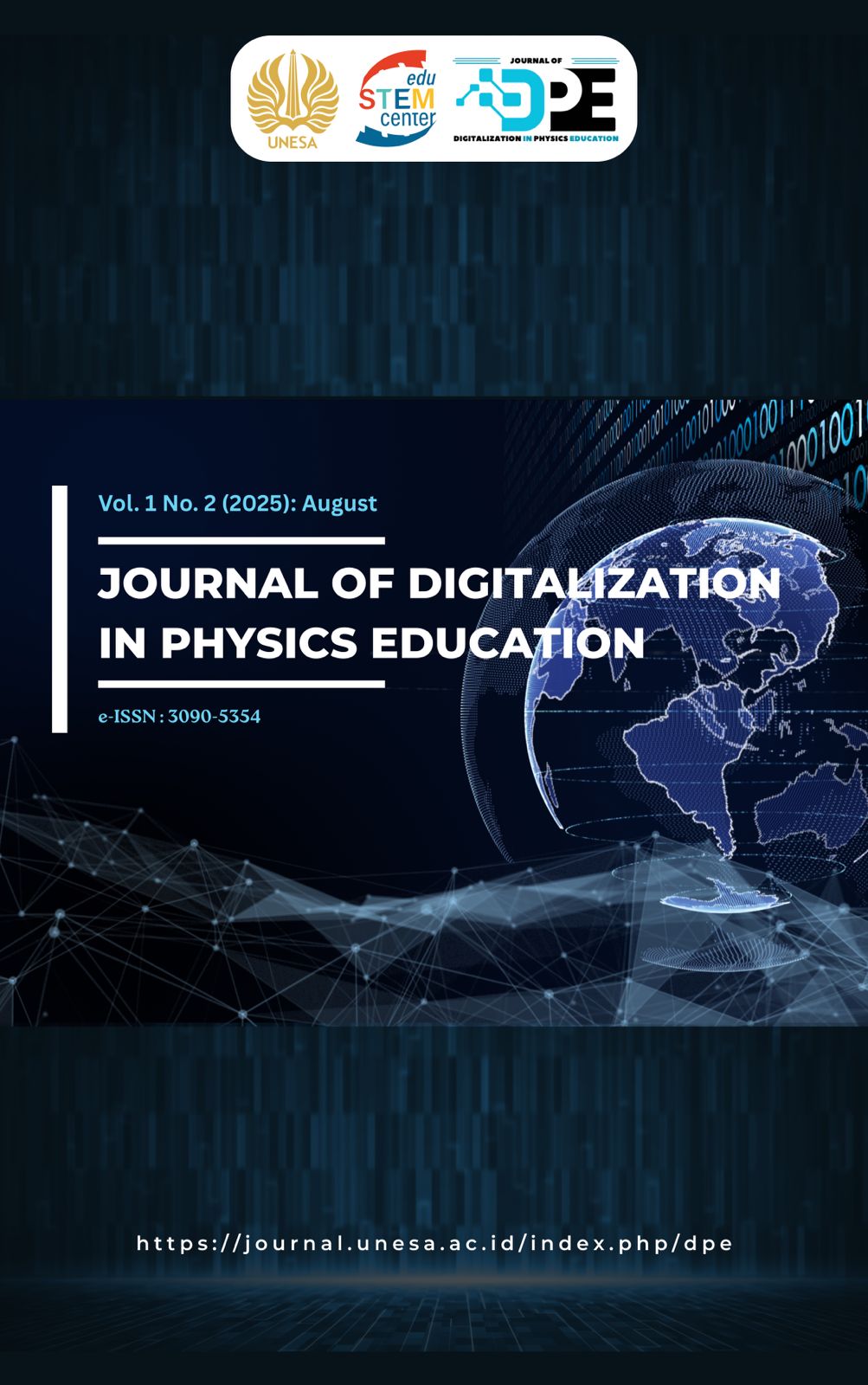The Effectiveness of G-Sites-Based Learning to Improve Students' Critical Thinking Skills
DOI:
https://doi.org/10.26740/jdpe.v1i2.41960Keywords:
Educational Innovation, G-Sites, Interactive, Learning MediaAbstract
Objective: This study aims to develop and evaluate the effectiveness of G-Sites-based learning media to improve students' critical thinking skills, particularly in understanding the physics topic of the electrical obstacle series. With the growing need for engaging and flexible digital learning solutions, this research addresses how interactive web-based media can enhance learning outcomes in science education. Method: The research employed a 3D development model consisting of Define, Design, and Develop. Learning needs were identified through student surveys, and the media was designed using G-Sites, which incorporated features such as videos, quizzes, and interactive simulations. The developed media was validated by experts and tested on 59 high school students in a limited classroom trial at SMAN 1 Ngimbang. Data were analyzed quantitatively using validity scores and gain scores from pre-and post-tests. Results: The validation results showed that the learning media was highly valid in terms of design, content, interactivity, and technical aspects, with scores exceeding 90%. Student learning outcomes improved significantly, as shown by increased post-test scores. Feedback indicated that students found the media engaging, accessible, and preferable compared to conventional methods. Novelty: This study introduces the innovative use of Google Sites as a free, accessible, and flexible platform for developing interactive physics learning media. Unlike many commercial platforms, G-Sites allows educators to independently create customized, multimedia-rich content tailored to their students' needs, representing a practical and scalable solution for digital learning in resource-constrained environments.
References
Almendo Thio Lindra, C., Budiningsih, C. A., & Ismaniati, C. (2025). Development of Google Sites based learning media to enhance student motivation. Inovasi Kurikulum, 22(2), 933–950. https://doi.org/10.17509/jik.v22i2.81886
Ariyanto, A. (2018). Development of interactive website-based learning media. CV. Pustaka Setia.
Azhar, A. (2011). Learning media. Jakarta: Raja Grafindo Persada.
Bruner & Jerome, S. (1966). Toward a theory of instruction. Cambridge: Harvard University Press.
Cahya, R. E., & Sucahyo, I. (2021). Development of wave on string simulation LKPD for stationary wave learning in high school. PENDIPA Journal of Science Education. 5(3): 366-371. https://doi.org/10.33369/pendipa.5.3.366-371
Dewi, A. R., & Candra, T. (2024). Interactive learning media utilizing Google Sites on quantum physics to enhance critical thinking skills. Jurnal Pendidikan IPA, 1(3), 45–58. https://ejournal.undiksha.ac.id/index.php/JPI/article/view/81217
Doyan, A., Susilawati, S., Harjono, A., Annam, S., Ikhsan, M., Ardianti, N. R., & Hakim, S. (2025). Development of modern physics learning media based on interactive web using the PJBL model to improve critical thinking skills: A systematic review. Jurnal Penelitian Pendidikan IPA, 11(2), 60–70. https://doi.org/10.29303/jppipa.v11i2.10388
Farhana, F., Suryadi, A., & Wicaksono, D. (2021). Pengembangan bahan ajar berbasis digital pada mata pelajaran Bahasa Inggris di SMK Atlantis Plus Depok. Jurnal Instruksional, 3(1), 1–17. https://doi.org/10.24853/instruksional.3.1.1-17
Gagné, R. M., & Briggs, L. J. (1974). Principles of instructional design. Holt, Rinehart and Winston.
Hamzah, B. (2017). Development of interactive learning media based on information and communication technology. Deepublish.
Heinich, R., Molenda, M., & Russell, S. (2002). Instructional media and technologies for learning. Merrill Prentice Hall.
Islamiah, I. n. (2021). The effectiveness of the use of Google Site learning media in increasing students' interest in learning the subject of Moral Beliefs at MTsN 4 Jombang [Master's thesis, Institut Agama Islam Negeri Purwokerto].
Khaeruddin, & Bancong, H. (2022). STEM education through PhET simulations: An effort to enhance students’ critical thinking skills. Physics Education Department, UIN Raden Intan Lampung. ERIC, EJ1437899.
Lindra, A. T., Budiningsih, C. A., & Ismaniati, C. (2025). Development of Google Sites-based learning media to enhance student motivation. Inovasi Kurikulum, 22(2), 933–950. https://doi.org/10.17509/jik.v22i2.81886
Maryani, M., Nisak, M. S., & Supriadi, B. (2022). Implementation of Google Sites web based learning media to improve problem solving skills for high school students: The subject of sound waves. Jurnal Penelitian Pendidikan IPA, 8(4), 2136–2144. https://doi.org/10.29303/jppipa.v8i4.2037
Mayer, R. E. (2001). Multimedia learning. Cambridge University Press.
Moleong, L. J. (2017). Metodologi penelitian kualitatif. Remaja Rosdakarya.
Munir, F., et al. (2023). The effect of interactive learning media on students’ science learning outcomes. In Proceedings of the ACM Conference on Educational Media (pp. 210–219). ACM.
Ningrum, D. I. P. C., & Jumadi. (2024). Development of physics websites based on STEM assisted Google Sites on momentum and impulse materials to improve creative thinking skills. Jurnal Penelitian Pendidikan IPA, 10(9), 6766–6776. https://doi.org/10.29303/jppipa.v10i9.5168
Riduwan, & Akdon. (2013). Formula dan data dalam aplikasi statistik. Alfabeta.
Saputra, A. R., Murti, R. C., & Hastuti, W. S. (2025). The effect of web based interactive learning media on elementary students’ critical thinking skills. Jurnal Prima Edukasia, 13(1), 159–168. https://doi.org/10.21831/jpe.v13i1.75228
Squirming & Squirming. (2013). Formulas and data in statistical applications. Bandung: Alfabeta.
Solihudin, T. J. H. (2018). Pengembangan e-modul berbasis web untuk meningkatkan pencapaian kompetensi pengetahuan fisika pada materi Listrik Statis dan Dinamis SMA. Jurnal Wahana Pendidikan Fisika, 3(2), 51-61. https://doi.org/10.17509/wapfi.v3i2.13731
Silberman, M. L. (2018). Learning activities. Bandung: Remaja Rosdakarya.
Sudjana, N. (2005). Metode statistika. Bandung: Tarsito.
Sugiyono. (2016). Metode penelitian kuantitatif, kualitatif, dan R&D. Bandung: Alfabeta.
SyafriafdiN. (2020). The Role of Educational Technology in Learning.06 (01), 1–8
Thio Lindra, A., Budiningsih, C. A., & Ismaniati, C. (2025). Development of Google Sites based learning media to enhance student motivation. Inovasi Kurikulum, 22(2), 933–950. https://doi.org/10.17509/jik.v22i2.81886
Trianto. (2010). Constructivist-oriented innovative learning models. Library Achievements.
Wahyuni, S., & Yani, A. (2024). Improving students’ critical thinking skills through PBL based Google Sites learning media and review students’ collaboration skills. Journal of Social Research, 3(10), 2279. https://doi.org/10.55324/josr.v3i10.2279
Wiggins, Grant, & McTighe, Jay. (2005). Understanding by design. Alexandria, VA: Association for Supervision and Curriculum Development (ASCD).
Downloads
Published
How to Cite
Issue
Section
License
Copyright (c) 2025 Journal of Digitalization in Physics Education

This work is licensed under a Creative Commons Attribution 4.0 International License.
 Abstract views: 114
,
Abstract views: 114
, PDF Downloads: 133
PDF Downloads: 133


